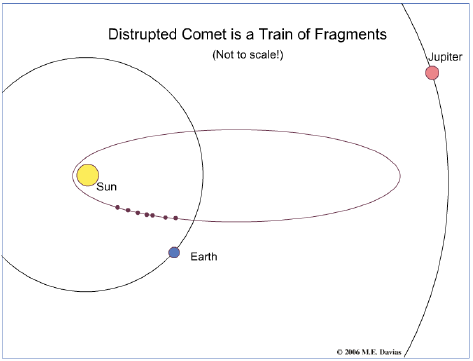Proposed Comet Astrophysics
Our proposal for a shallow, but massive, impact at Saginaw, MI, suggests that the impactor was not fully integrated into the crater. While the cometary body was possibly 50 to 100 km in diameter, the near-tangential strike may have involved only a few kilometers of vertical interface. The rim of the comet would have sheared off on contact, while the vast majority of its mass would have "decapitated" and, its momentum barely perturbed, continued on its heliocentric orbit, away from the influence of Earth's gravity.
Prior to the collision with Earth, the parent body may have been a long period comet. Because of the momentum lost during the interface with Earth, the comet could have moved to a small perihelion, small period orbit. Drag from atmospheric and terrestrial interfaces, along with tidal forces, may have rendered that body into a tightly bound yet fragmented stream as it continued on its way on a Earth crossing orbit, where it remains to this day, although greatly depleted by dissipation over the past 800 thousand years.

Such an event would necessarily require that at least some of those cometary elements would have remained in the inner solar system to this day, and would therefore be available for inspection. Does such a collection of earth-crossing cometary fragments exist? Yes, the Taurid Complex.
The Taurid Complex is a cometary debris stream revolving around the Sun in an earth-crossing orbit. (http://star.arm.ac.uk/~aac/zetataur.html). Analysis suggests that during the recent past, a significant mass has been removed from the Taurid progenitor. There is only one large comet in the Taurid stream today, 2p/Encke. A good overview of the comet is available at Gary Kronk's Cometography.
Steel, Asher, and Clube have derived a cometary model for the distribution of dust in the zodiac cloud, which is presented in their paper, The structure and evolution of the Taurid complex (Royal Astronomical Society, Monthly Notices (ISSN 0035-8711), vol. 251, Aug. 15, 1991, p. 632-648.). Their numerical analysis yields a theorized single large cometary body entering the inner solar system 20,000 to 30,000 years ago. Further, they propose that it came to the end of its principal activity 10,000 years ago. We note that the timing of this activity correlates with the stabilization of the earth’s temperature. Steel, Asher, Clube and Napier were unable to adequately explain the final distribution of the parent comet’s mass, although various possible explanations were presented. [1, 2, 3, 4]
William Napier has commented recently on the potential involvement of the Taurid Complex in the Carolina bay Impact discussion. [5] "The Taurid Complex appears to be the debris of this erstwhile comet; it includes at least 19 of the brightest near-Earth objects. "
[1] Clube V. and Napier W., Mankind's future: an astronomical view:
comet, ice ages and catastrophes, Interdisciplinary Sciences Reviews
II, 236-247, 1986
[2] Clube V. and Napier W., The cometary break-up hypothesis
re-examined: a reply, Monthly Notices Royal. Astr. Soc. 225, 55-58,
1987
[3] Clube V. and Napier B.: The micro structure of terrestrial
catastrophism, Preprint, Royal Observatory, Edinburgh, 1984
[4] Clube V. and Napier B.: The cosmic serpent, Faber and Faber, 1982
[5] Napier, W.M., 2010, Paleolithic extinctions and the Taurid Complex, Royal Astronomical Society arXiv:1003.0744v1 [astro-ph.EP]


